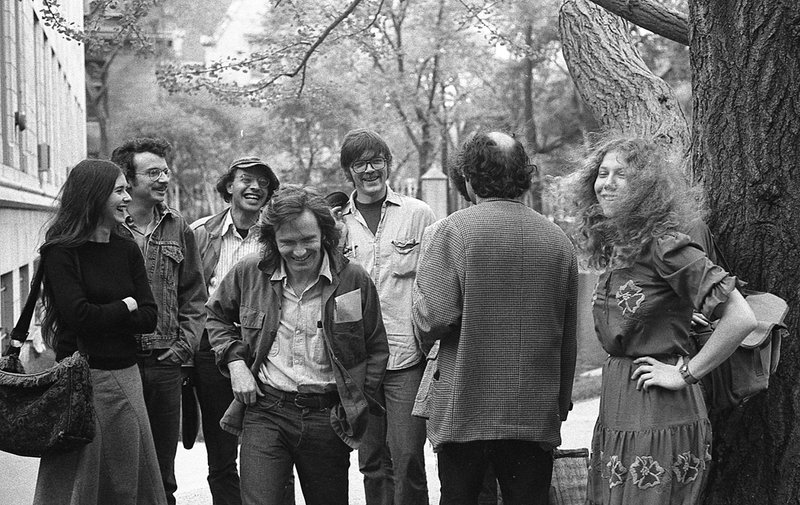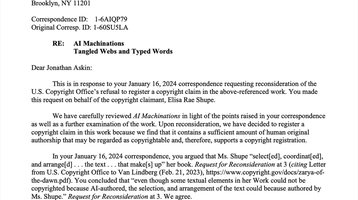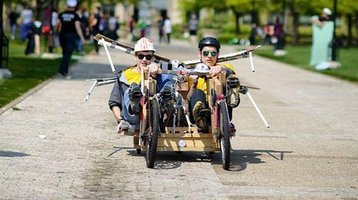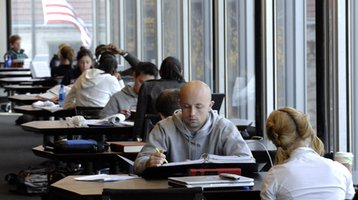Hundreds of photographs depicting UChicago student life in the 1970s added to online archive
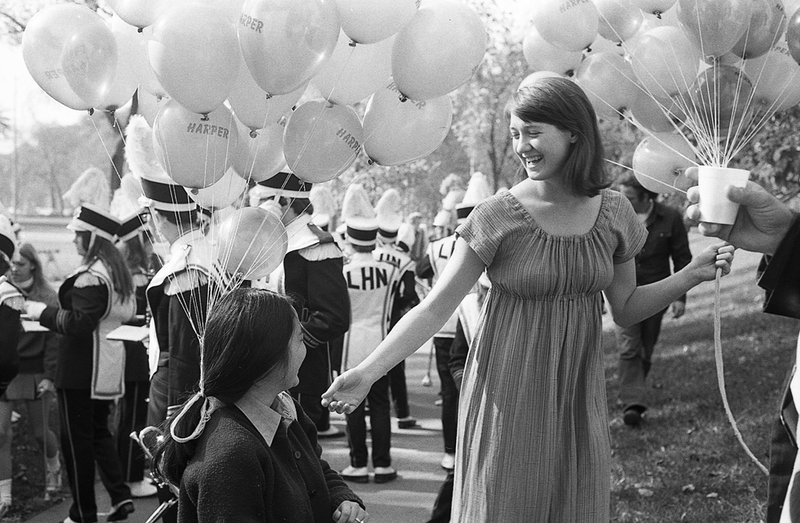
Rededication of Harper Library; the Parade, October 26, 1973. University of Chicago Photographic Archive, apf4-04113, Hanna Holborn Gray Special Collections Research Center, University of Chicago Library.
More than 850 photographs by UChicago alumnus Frank Gruber (AB'74) have recently been added to the University of Chicago Photographic Archive (UCPA).
UCPA is a database of almost 50,000 images documenting the history of the University and its communities from the 19th to the 21st centuries. In addition to the Hanna Holborn Gray Special Collections Research Center’s core collection of prints and negatives, the Archival Photofiles, UCPA includes photos from the Chicago Maroon, Yerkes Observatory, the University’s News Office, the Botany Department, the papers of Ida B. Wells, and photographs taken by Mildred Mead of Hyde Park and other southside communities before and during the urban renewal projects of the 1950s and 60s.
Gruber’s photographs are the first large-scale addition of an alumni donation to UCPA, and their preparation was a collaborative effort between graduate student assistants, Library staff, and the photographer. Former Assistant University Archivist Eileen Ielmini contacted Gruber after seeing an online display that he had prepared for the fortieth reunion of the Class of 1974. Recognizing that his photographs offered a unique depiction of campus life from an era not well-documented in the University Archives, Ielmini asked if Gruber would consider a donation of the images to the Library. Gruber embarked on a project to create high-resolution scans of his original negatives, and to compile descriptions identifying the people, places, and events in the images. Head of Archives Processing and Digital Access Kathleen Feeney worked with graduate students Jerusha Crone, Melissa Robohn, and Emily Jelen to turn Gruber’s descriptions into individual metadata records for each image.
The full collection of Frank Gruber’s photos may be browsed in UCPA. A selection is available here.
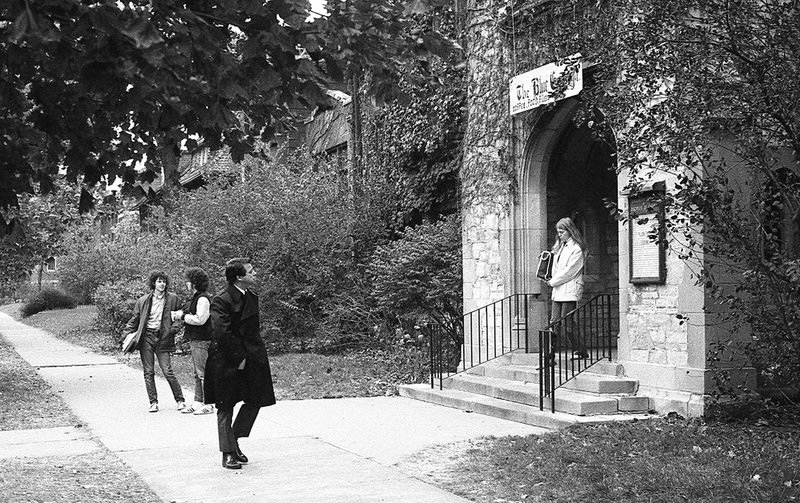
People outside the Blue Gargoyle, November 1973. Founded as a coffee house in 1968 by UChicago Divinity School students, the Blue Gargoyle expanded to become a nonprofit literacy and tutoring program that served many South Side residents. University of Chicago Photographic Archive, apf4-04177, Hanna Holborn Gray Special Collections Research Center, University of Chicago Library.
Frank Gruber described his journey as a student photographer:
"I came to the University of Chicago in the fall of 1970 with a cheap East German 35mm camera. I had been using the camera during high school, mostly to take pictures for my high school yearbook, but also during a post-high school hitchhiking adventure in Europe the summer after graduation. I wanted to get better at photography, and I joined the Maroon’s photography staff. I came under the wing of the paper’s photo editor, Steve Aoki, who taught me a lot about processing film and making prints. I took many of my first-year photographs for the Maroon, which meant often photographing demonstrations, political meetings, and portraits of professors. It was good experience.
In spring quarter of my first year, I got lucky. Through a friend of my family I was hired to sell charter flights to Europe. I made $800, which was a lot of money back then. When I returned home in June, I got lucky again. A neighbor wanted to sell his Leica M3, and with the money I had made I was able to buy it from him, with two lenses, for $400. Having the Leica changed my attitude towards photography. Don’t ask me why, but there is something about looking through the rangefinder of a Leica that is different.
That summer I went to Europe. My family was living in Rome at the time because my father was then the director of the Rome branch of Temple University. I took a lot of photographs that summer. Because Temple had a darkroom, I was able to process the film quickly after shooting it. That helped improve my technique. In the middle of that summer my family took a long trip to southern Italy. That enabled me to take photographs of religious processions, markets, that kind of thing. Fifty years later, I was able to have two exhibitions of these photographs in Italy.
When I returned to Chicago in the fall, like many if not most students I moved out of the dorms into an apartment. Rents were low in Hyde Park then and it was much cheaper to live off campus. I had a roommate and we alternated cooking and cleaning, and each week got our vegetables and fruit from a food coop. I set up a little darkroom in one of the bathrooms. Living in an apartment those days was all about your group of friends. It seemed like you did everything with them except go to class: movies at DocFilms, coffee in Cobb Hall, and best of all meals we cooked and shared in each other’s apartments. Aside from the pleasure I got, and still get, from composing an image in the camera and pressing the shutter button, I am not sure why I felt the need to photograph my friends and what was happening on campus, but it became the thing that I did. My identity.
I was also able to make a little money with photography. My academic advisor, a wonderful woman named Nancy O’Connor, hired me to photograph her two toddler boys. Then some friends of hers hired me to do the same with their kids. That was fun, and I made a little money, which was good because I needed it to pay for film, paper, chemicals, etc.
In my fourth year, somehow it came about that I could have a show of my UC photographs at the University’s Midway Studios. This was going to take place in February 1974. In January I was still looking for a title for the show, when I bumped into Sally Banes in line at the bank. Sally later became a noted scholar of dance, but at that time she herself was a choreographer who worked with a troupe called the Community Discount Players. I told Sally about my show coming up, and that I was looking for a title, and she said something like, “well, I’m going to have a show, and I am calling it ‘A Day in the Life of the Mind’; why don’t you call yours ‘A Day in the Life of the Mind (Part 1)’ and mine will be part 2.”
My show at Midway Studios was a highlight of my college experience, but Sally’s show was incredible. It took place that spring. A Day in the Life of the Mind, Part 2 was a six-hour environmental theater/dance performance that started on the banks of Lake Michigan in mid-afternoon. Then the show gradually moved west through Hyde Park, with several stops, including a dinner break, and concluded outside Regenstein Library. I participated two ways. First, ahead of time Sally had me photograph a friend of ours, Vera Aronow, playing the role of Nadja Sabe. Nadja was a fictional character who lived in an apartment in Hyde Park. Photographs I took of Vera acting out day-to-day scenes in the life of the character were on the wall of the apartment. Audience members walked through the apartment while various other activities illustrating the life of Nadja took place. The second way I participated was to photograph the performance from beginning to end. These photographs are included in the archive.
When Eileen Ielmini first contacted me and asked if I would donate my photographs to the archive, I am sure that neither of us realized how many photographs there were or how much work it would take. The process of scanning and inputting took about three years, and then it took more years for the Archives to do their processing, but now the collection of more than 800 images is online and available to the public. The images are now half a century old, and I hope they are a window into that time."
